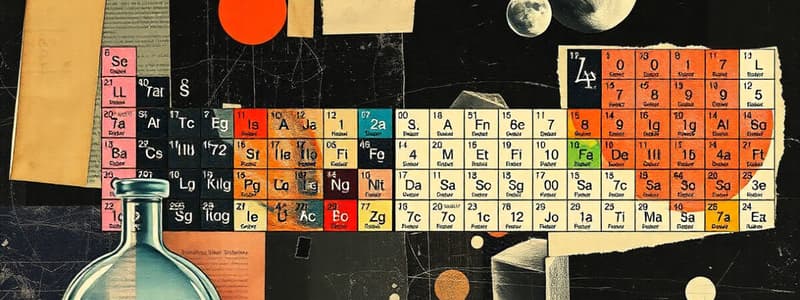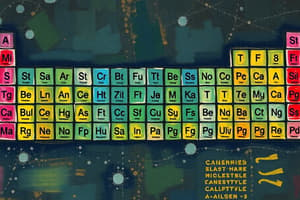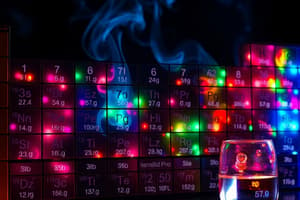Podcast
Questions and Answers
Explain how the number of protons in the nucleus of an atom affects its first ionisation energy and why?
Explain how the number of protons in the nucleus of an atom affects its first ionisation energy and why?
As the number of protons increases, the positive charge of the nucleus also increases. This results in a stronger attraction for electrons, thus more energy is needed to remove an electron.
Describe the relationship between atomic radius and first ionisation energy. Why does this relationship exist?
Describe the relationship between atomic radius and first ionisation energy. Why does this relationship exist?
As atomic radius increases first ionization energy decreases. This is because valence electrons are further from the nucleus and, thus, easier to remove.
How does electronegativity differ between elements that readily lose electrons versus those that readily gain electrons?
How does electronegativity differ between elements that readily lose electrons versus those that readily gain electrons?
Elements that readily lose electrons have low electronegativity, while those that readily gain electrons have high electronegativity.
Explain how the number of electron shells affects the first ionisation energy of an element.
Explain how the number of electron shells affects the first ionisation energy of an element.
What two factors determine the electronegativity of an element?
What two factors determine the electronegativity of an element?
Describe how first ionisation energy changes as you move down a group in the Periodic Table.
Describe how first ionisation energy changes as you move down a group in the Periodic Table.
Does sodium (Na) or chlorine (Cl) have a higher electronegativity? Briefly explain why.
Does sodium (Na) or chlorine (Cl) have a higher electronegativity? Briefly explain why.
Describe how first ionisation energy changes as you move across a period in the Periodic Table.
Describe how first ionisation energy changes as you move across a period in the Periodic Table.
Explain why electronegativity generally increases across a period in the periodic table.
Explain why electronegativity generally increases across a period in the periodic table.
Describe the trend in electronegativity as you move down a group in the periodic table and provide a reason for this trend.
Describe the trend in electronegativity as you move down a group in the periodic table and provide a reason for this trend.
How does the effective nuclear charge influence the trend in atomic radius across a period?
How does the effective nuclear charge influence the trend in atomic radius across a period?
Explain why metallic character decreases across a period.
Explain why metallic character decreases across a period.
Describe the trend in atomic radius as you move down a group in the periodic table, and explain the underlying reason.
Describe the trend in atomic radius as you move down a group in the periodic table, and explain the underlying reason.
In terms of electron behavior, what makes an element exhibit strong metallic character?
In terms of electron behavior, what makes an element exhibit strong metallic character?
How does increased shielding affect the electronegativity of an atom?
How does increased shielding affect the electronegativity of an atom?
Explain the relationship between atomic radius and ionization energy. How does the trend in atomic radius influence the trend in ionization energy across a period?
Explain the relationship between atomic radius and ionization energy. How does the trend in atomic radius influence the trend in ionization energy across a period?
How does the atomic radius generally change as you move down a group (vertical column) in the periodic table? Briefly explain the reason for this trend.
How does the atomic radius generally change as you move down a group (vertical column) in the periodic table? Briefly explain the reason for this trend.
Define the term 'first ionisation energy'.
Define the term 'first ionisation energy'.
Comparing Sodium, Potassium and Lithium, which element would you expect to have the LOWEST first ionization energy? Explain your reasoning.
Comparing Sodium, Potassium and Lithium, which element would you expect to have the LOWEST first ionization energy? Explain your reasoning.
How does the electronegativity trend change as you move across a period (horizontal row) from left to right on the periodic table? Briefly explain the underlying cause.
How does the electronegativity trend change as you move across a period (horizontal row) from left to right on the periodic table? Briefly explain the underlying cause.
Consider the elements Oxygen and Fluorine. Which element is more electronegative, and how does its position on the periodic table relate to its electronegativity?
Consider the elements Oxygen and Fluorine. Which element is more electronegative, and how does its position on the periodic table relate to its electronegativity?
Explain how the metallic character of elements changes as you move down Group 1 (alkali metals). Relate your answer to ionization energy.
Explain how the metallic character of elements changes as you move down Group 1 (alkali metals). Relate your answer to ionization energy.
Predict which of the following elements has the most metallic character: Sodium, Aluminum, or Silicon. Explain your reasoning based on periodic trends.
Predict which of the following elements has the most metallic character: Sodium, Aluminum, or Silicon. Explain your reasoning based on periodic trends.
How does 'shielding' by inner electrons affect the effective nuclear charge experienced by valence electrons, and how does this influence ionization energy?
How does 'shielding' by inner electrons affect the effective nuclear charge experienced by valence electrons, and how does this influence ionization energy?
Flashcards
First Ionization Energy
First Ionization Energy
The energy required to remove one electron from a neutral atom in its gaseous phase.
Small First Ionization Energy
Small First Ionization Energy
Elements with a smaller first ionization energy tend to lose electrons to achieve stability.
Large First Ionization Energy
Large First Ionization Energy
Elements with a larger first ionization energy tend to gain electrons to achieve stability.
Ionization Energy Across a Period
Ionization Energy Across a Period
Signup and view all the flashcards
Ionization Energy Down a Group
Ionization Energy Down a Group
Signup and view all the flashcards
Electronegativity
Electronegativity
Signup and view all the flashcards
High Electronegativity
High Electronegativity
Signup and view all the flashcards
Low Electronegativity
Low Electronegativity
Signup and view all the flashcards
Periodic Table Trend
Periodic Table Trend
Signup and view all the flashcards
Group 1 Reactivity
Group 1 Reactivity
Signup and view all the flashcards
Reactivity Trend: K, Na, Li
Reactivity Trend: K, Na, Li
Signup and view all the flashcards
Atomic Radius & Reactivity
Atomic Radius & Reactivity
Signup and view all the flashcards
Element starting with M
Element starting with M
Signup and view all the flashcards
Element starting with C
Element starting with C
Signup and view all the flashcards
Symbols of elements
Symbols of elements
Signup and view all the flashcards
Electronegativity trend across a period
Electronegativity trend across a period
Signup and view all the flashcards
Electronegativity trend down a group
Electronegativity trend down a group
Signup and view all the flashcards
Metallic Character
Metallic Character
Signup and view all the flashcards
Metallic character trend across a period
Metallic character trend across a period
Signup and view all the flashcards
Metallic character trend down a group
Metallic character trend down a group
Signup and view all the flashcards
Atomic Radius
Atomic Radius
Signup and view all the flashcards
Atomic radius trend across a period
Atomic radius trend across a period
Signup and view all the flashcards
Study Notes
- A trend in the periodic table refers to a predictable pattern or change in element properties across a row (period) or down a column (group).
- These trends can be used to explain physical/chemical properties of different elements.
- The trends also help understand why an element is located in its specific spot on the periodic table.
- Lithium, sodium, and potassium are Group 1 elements that react violently with water.
- Potassium's larger atomic radius means less energy is needed to remove its valence electron, increasing reactivity.
First Ionization Energy
- It is the energy needed to remove the first electron from an atom.
- Elements with few electrons have small first ionization energies, as their atoms prefer to lose electrons.
- Elements with many electrons tend to have high first ionization energies because their atoms prefer to gain electrons to become stable.
- First ionization energy increases from left to right across a period due to a rising number of protons, increasing the nucleus' positive charge.
- Greater pull on electrons by the nucleus requires more energy to remove them.
- First ionization energy decreases down a group as valence electrons are farther from the nucleus due to more energy levels, meaning they are not held as tightly.
Electronegativity
- Electronegativity is the ability of an atom to attract electrons in a chemical bond.
- High electronegativity elements need only a few more electrons to fill their valence shell, and has a small atomic radius.
- Low electronegativity elements lose electrons to fill their valence shell (metals) and have a large atomic radius.
- Electronegativity increases from left to right across a period as there is a higher positive charge to pull electrons in.
- Electronegativity decreases down a group because more electron shells means the outermost electrons being further from the nucleus, decreasing the nucleus to attract additional electrons.
Metallic Character
- Metallic character decreases from left to right across a period.
- Metallic character increases down a group.
Atomic Radius
- Atomic radius decreases from left to right across a period.
- Increasing the positive charge of the nucleus attracts the electrons, pulling them closer, thus decreasing atomic size.
- Atomic radius increases down a group as each element has an additional electron shell.
- Additional electron shells means the outermost electrons are located further from the nucleus.
Studying That Suits You
Use AI to generate personalized quizzes and flashcards to suit your learning preferences.



